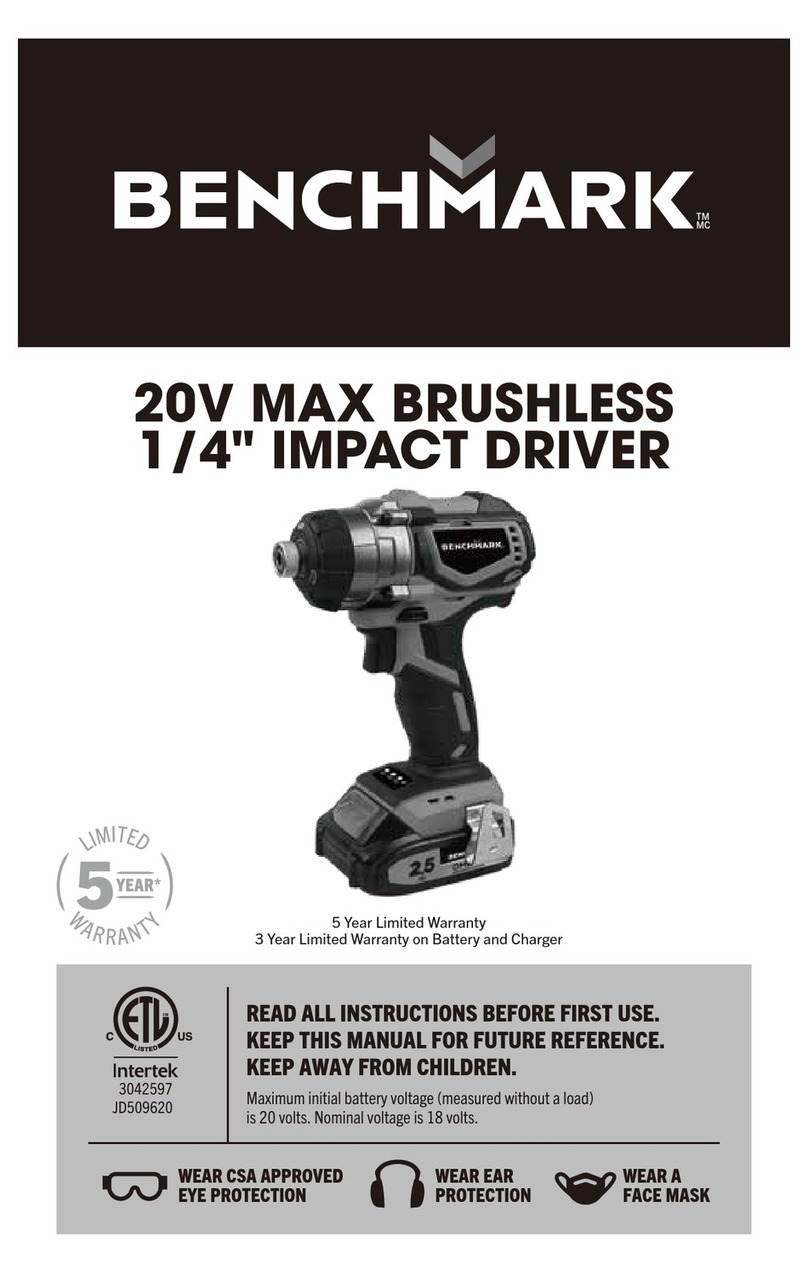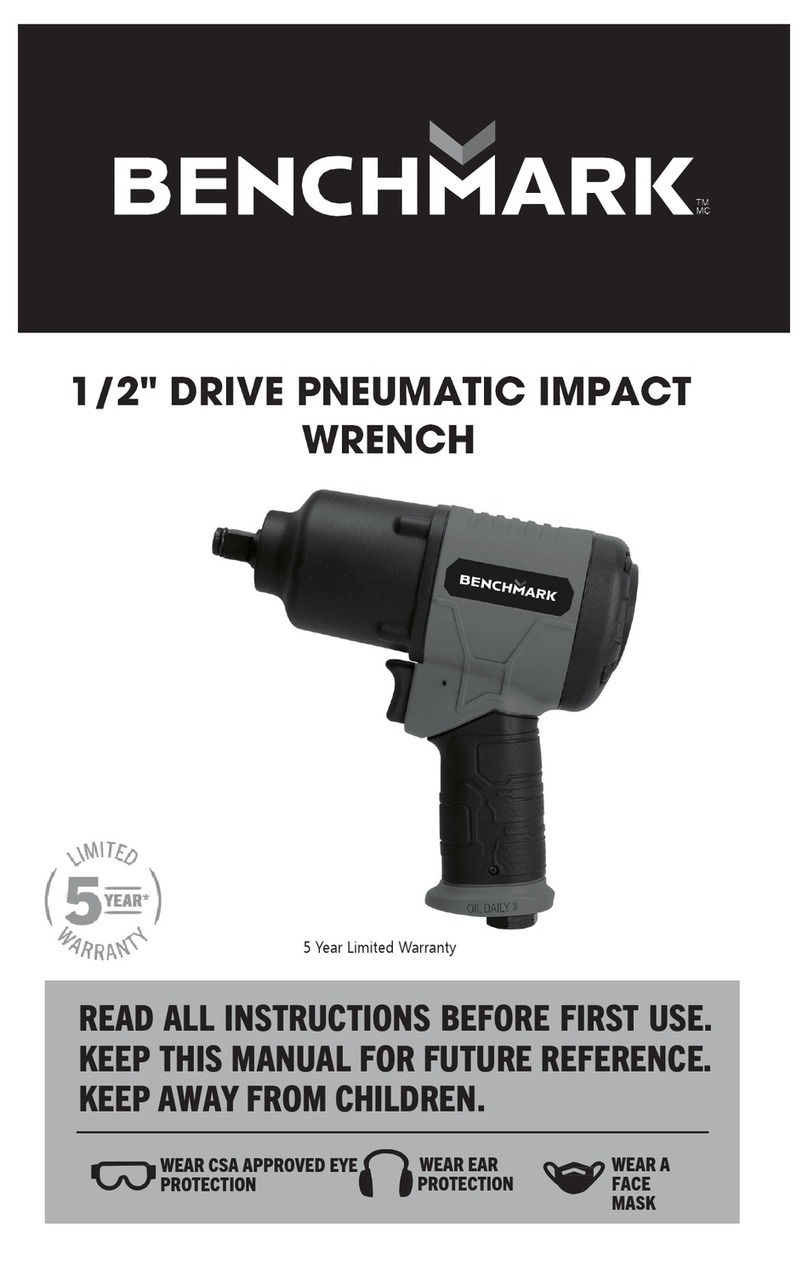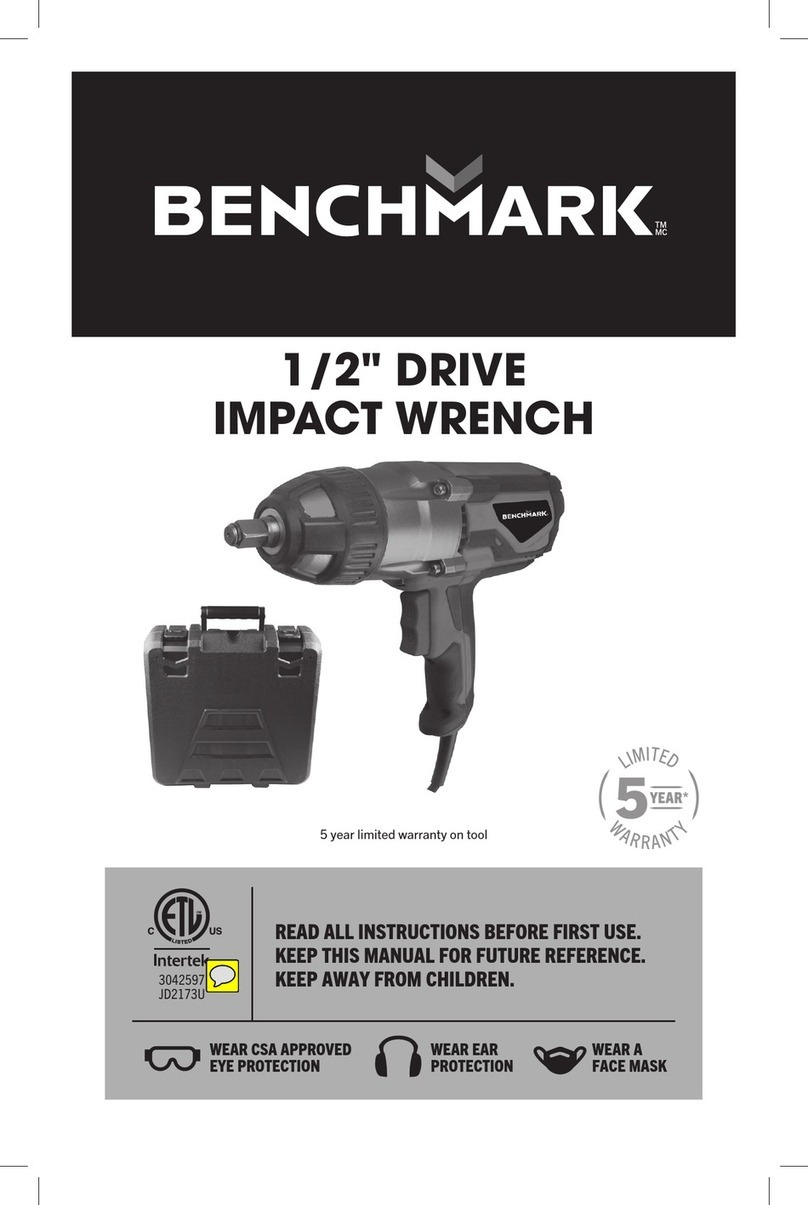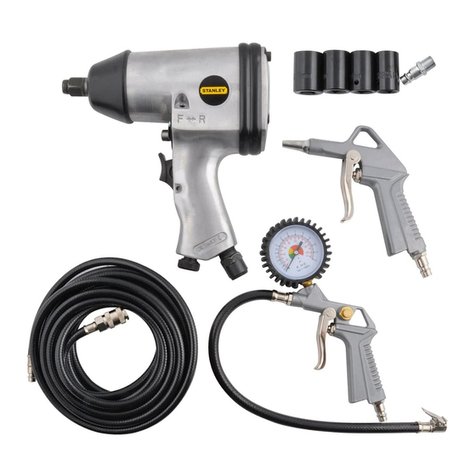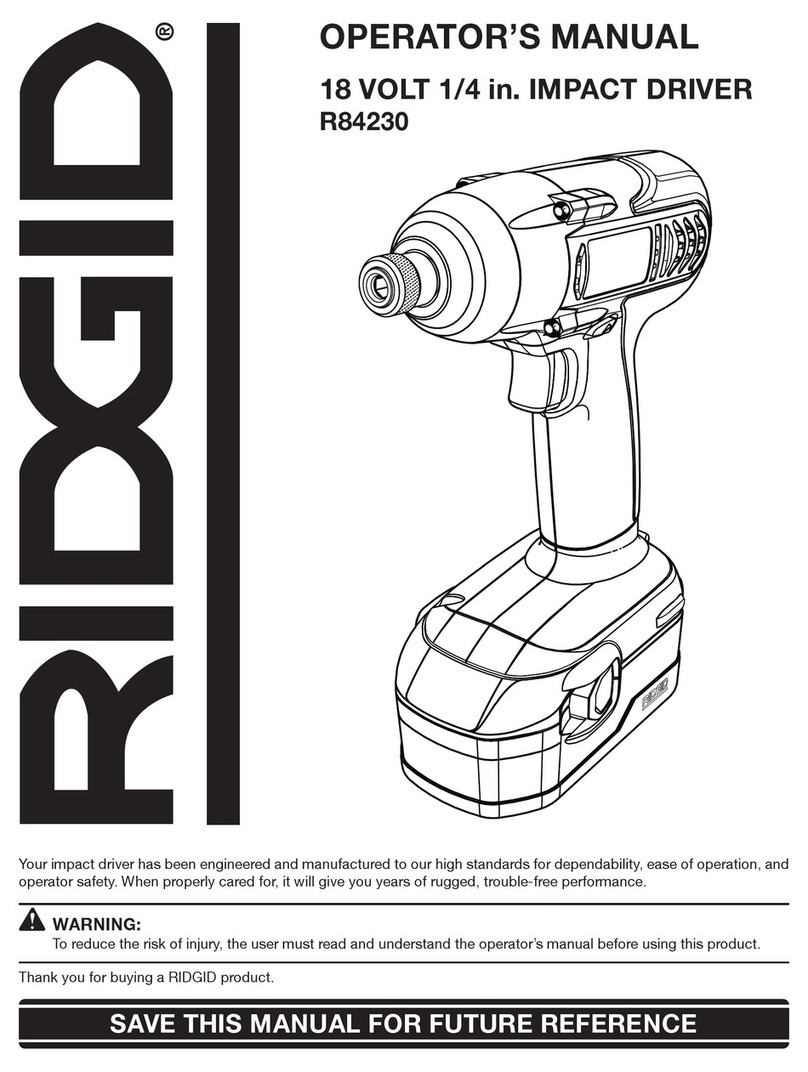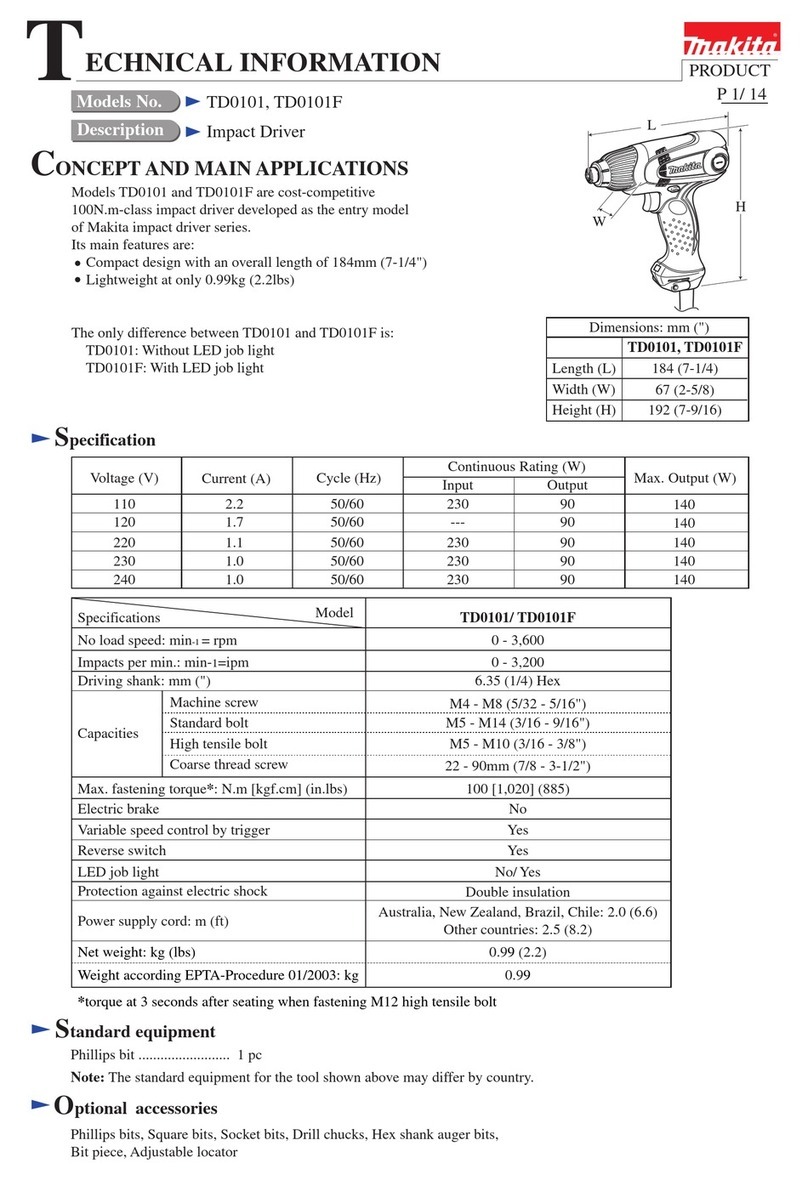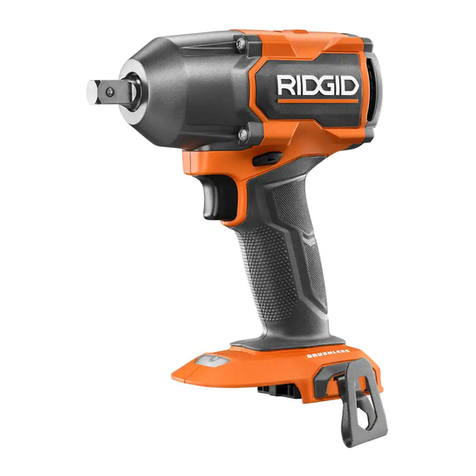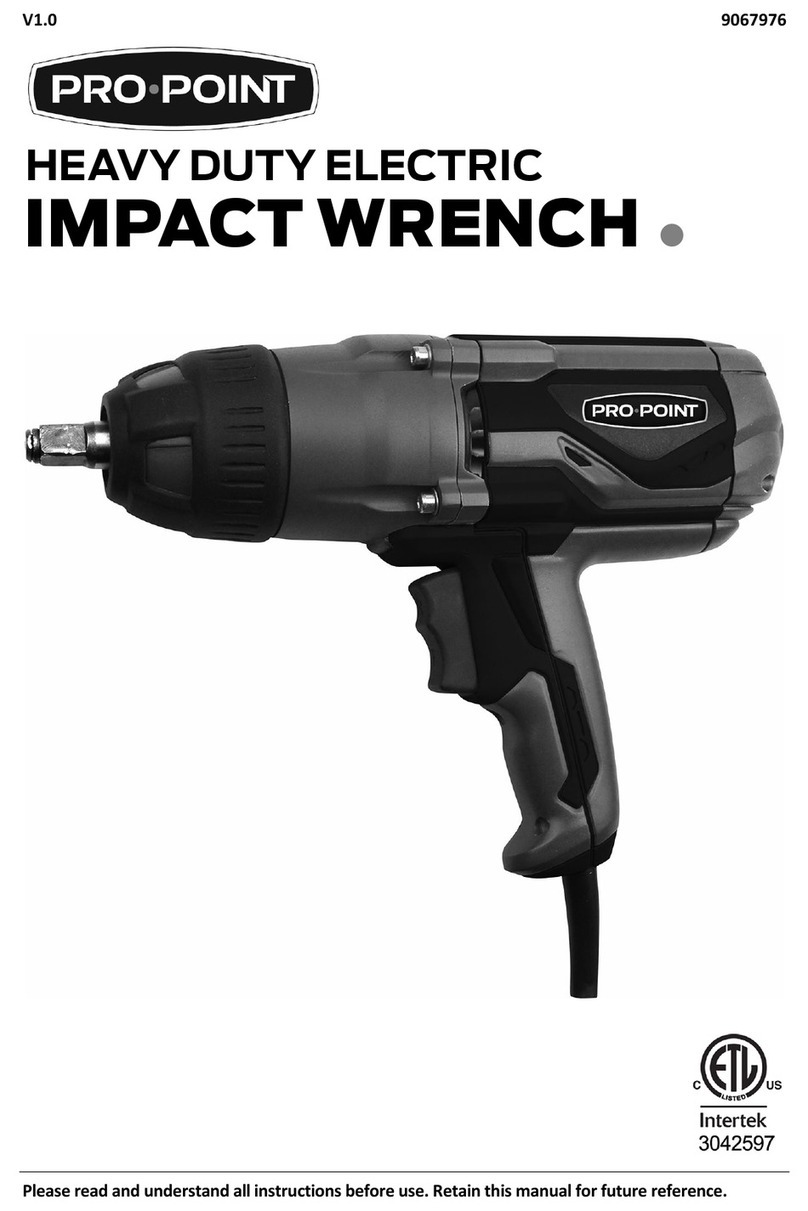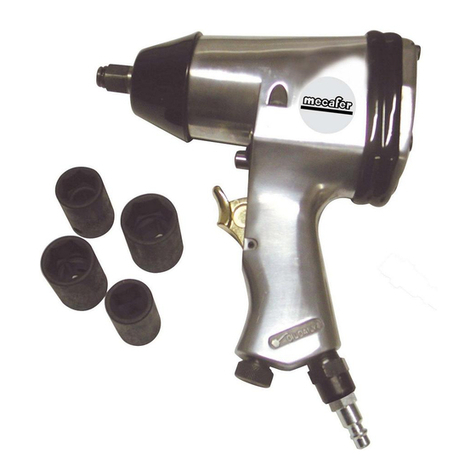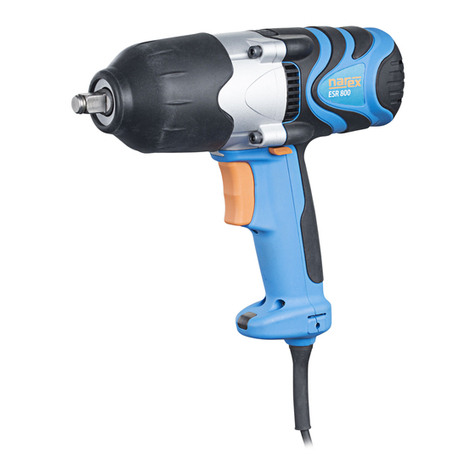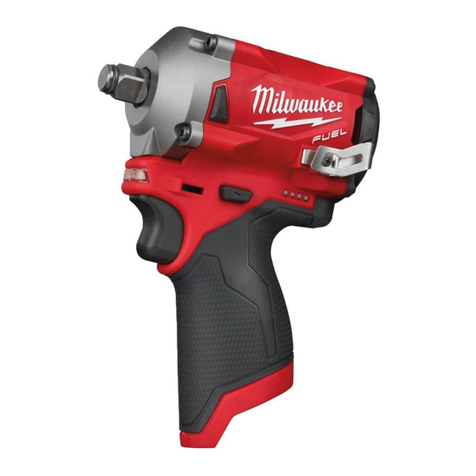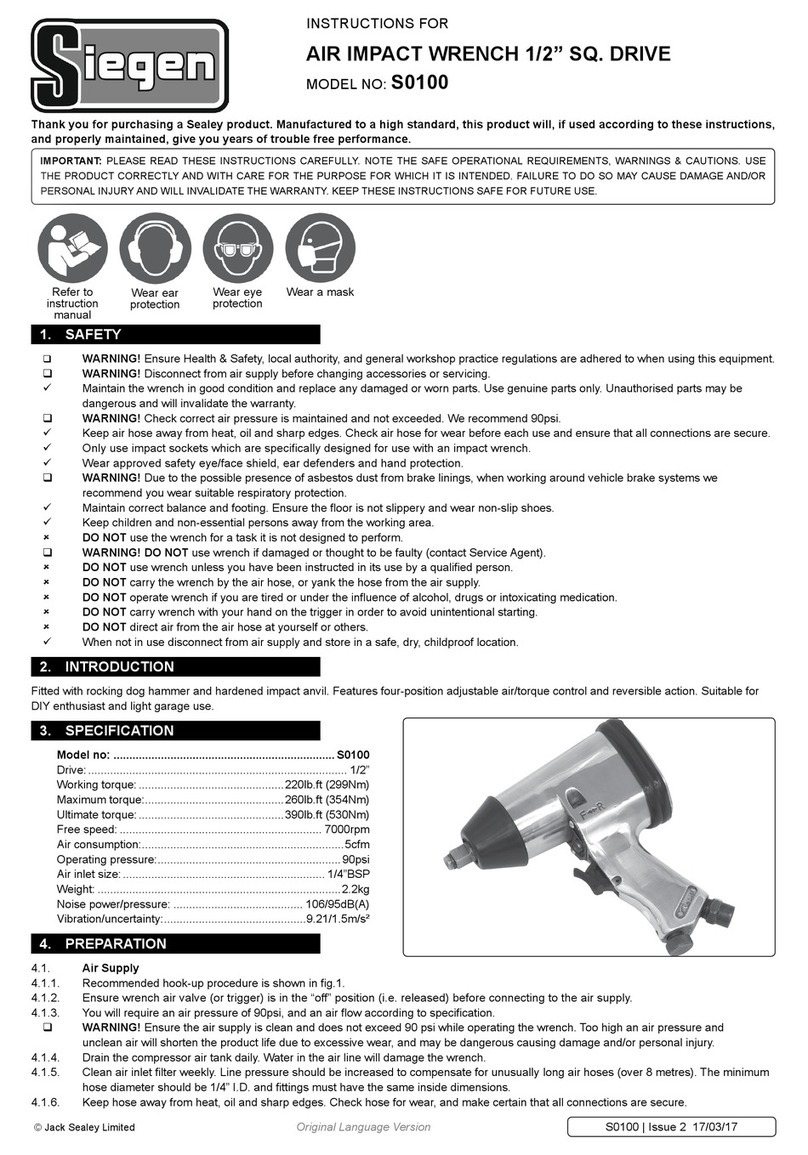Benchmark 1239-301 User manual

20V MAX BRUSHLESS
1/2" IMPACT WRENCH
WEAR CSA APPROVED
EYE PROTECTION
WEAR EAR
PROTECTION
WEAR A
FACE MASK
3042597
JD509820
READ ALL INSTRUCTIONS BEFORE FIRST USE.
KEEP THIS MANUAL FOR FUTURE REFERENCE.
KEEP AWAY FROM CHILDREN.
Maximum initial battery voltage (measured without a load)
is 20 volts. Nominal voltage is 18 volts.
5 Year Limited Warranty
3 Year Limited Warranty on Battery and Charger

1
PRODUCT SPECIFICATIONS
20V MAX BRUSHLESS 1/2" IMPACT DRILL
Volts 20V
Variable Two Speeds 0–2200/0-2700 RPM (no load)
2 Variable Impact Speeds 0–2600/0-3000 BPM
Torque 380 ft/lbs.
Square Drive 1/2”
Weight 4.6 lbs. (2.08kg) with battery
Battery 20V 4Ah Li-ion (Maximum charged
battery voltage, measured without load,
is 20V with a nominal value of 18V)
Replacement Battery 5350-011 (4Ah) Charge time –
up to 120 minutes
Replacement Charger Assembly 5350-010 (2.4A) up to 120 minutes
charge time
NEED ASSISTANCE?
Call us on our toll-free customer support line:
1-866-349-8665 (Monday through Friday 9am – 5pm Eastern Standard Time)
• Technical questions
• Replacement parts
• Parts missing from package

2
20V MAX BRUSHLESS 1/2" IMPACT WRENCH 1239-301
TABLE OF CONTENTS
Product Specifications .................................................................................. 1
Table of Contents .......................................................................................... 2
General Safety Instructions ........................................................................... 3
Eye, Ear & Lung Protection ............................................................................ 3
Electrical Safety ............................................................................................ 4
Power Tool Safety .......................................................................................... 4
Work Area Safety .......................................................................................... 4
Electrical Safety ............................................................................................ 4
Personal Safety ............................................................................................. 5
Power Tool Use and Care ............................................................................... 5
Specific impact wrench safety rules .............................................................. 6-7
Battery Pack Recycling ................................................................................. 8
Symbols ........................................................................................................ 9
20v Max Brushless 2vsr Impact Wrench.......................................................10
Assembly and Operation .............................................................................. 11
Checking the Battery Charge Status ............................................................ 11
Checking the Battery Pack .......................................................................... 11
Installing a Battery in the Impact Wrench .................................................... 12
Installing Impact Sockets ............................................................................. 13
Forward/Reverse Button............................................................................... 14
Variable Speed Trigger Switch...................................................................... 14
Speed and Auto-Stop Control ...................................................................... 15
Removing Fasteners .................................................................................... 15
Maintenance ............................................................................................... 16
General ....................................................................................................... 16
Lubrication .................................................................................................. 17
Lithium-ion Battery Performance ................................................................. 17
Lithium-ion Battery Maintenance ................................................................. 17
Battery Pack Removal and Preparation for Recycling.................................... 17
Exploded View ............................................................................................ 18
Parts List .................................................................................................... 19
Warranty ..................................................................................................... 20

3
GENERAL SAFETY INSTRUCTIONS
WARNING: Before using this tool or any of its accessories, read this manual
and follow all Safety Rules and Operating Instructions. The important precautions,
safeguards and instructions appearing in this manual are not meant to cover all
possible situations. It must be understood that common sense and caution are
factors which cannot be built into the product.
EYE, EAR & LUNG PROTECTION
SYMBOL MEANING
ALWAYS WEAR EYE PROTECTION THAT CONFORMS WITH CSA Z94.3 or
ANSI SAFETY STANDARD Z87.1
FLYING DEBRIS can cause permanent eye damage.
Prescription eyeglasses ARE NOT a replacement for proper eye protection.
The usage of a safety standard compliant face shield placed over proper
safety glasses or goggles can reduce the risk of facial injury.
Non-compliant eyewear can cause serious injury if broken during the
operation of a power tool.
Use hearing protection, particularly during extended periods of operation
of the tool, or if the operation is noisy.
WEAR A DUST MASK THAT IS DESIGNED TO BE
USED WHEN OPERATING A POWER TOOL IN A
DUSTY ENVIRONMENT.
Dust that is created by power sanding, sawing, grinding, drilling, and other
construction activities may contain chemicals that are known to cause
cancer, birth defects,
or other genetic abnormalities. These chemicals include:
• Lead from lead-based paints
• Crystalline silica from bricks, cement, and other
masonry products
• Arsenic and chromium from chemically treated lumber
The level of risk from exposure to these chemicals varies, according to how
often this type of work is performed. In order to reduce exposure to these
chemicals, work in a
well-ventilated area, and use approved safety equipment, such as a dust mask
that is specifically designed to filter
out microscopic particles.
TO AVOID ELECTRICAL HAZARDS,
FIRE HAZARDS OR DAMAGE TO THE TOOL,
USE PROPER CIRCUIT PROTECTION.
This tool is wired at the factory for 120 V AC operation. It must beconnected
to a 120 V AC, 15 A circuit that is protected by a time-delayedfuse or circuit
breaker. To avoid shock or fire, replace power cordimmediately if it is worn, cut
or damaged in any way.

4
WARNING: Ventilation openings in batteries and chargers must always
be open to allow cooling air to circulate freely. Air vents that are blocked,
restricted or covered may result in the battery or charger overheating.
Overheating may lead to damage to the tool or cause a fire, resulting in
possible serious injury.
POWER TOOL SAFETY
WARNING: Read all safety warnings and instructions. Failure to follow the
warnings and instructions may result in electric shock, fire and/or serious injury.
Save all warnings and instructions for future reference.
WORK AREA SAFETY
Keep work area clean and well lit. Cluttered or dark areas invite accidents.
Do not operate power tools in explosive atmospheres, such as in the presence
of flammable liquids, gases or dust. Power tools create sparks which may ignite
the dust or fumes.
Keep children and bystanders away while operating a power tool. Distractions
can cause you to lose control.
ELECTRICAL SAFETY
Double insulated tools are equipped with a polarized plug (one blade is wider
than the other). This plug will only fit into a polarized plug one way.
If the plug does not fit into the outlet properly, reverse the plug. If it still does
not fit, contact a qualified electrician to install a polarized outlet. Do not alter
the plug in any way. Double insulation eliminates the need for the three-pronged
grounded power cord and grounded power supply system.
Avoid body contact with earthed or grounded surfaces such as pipes, radiators,
ranges and refrigerators. There is an increased risk of electric shock if your body
is earthed or grounded.
Do not expose power tools to rain or wet conditions. Water entering a power tool
will increase the risk of electric shock.
Do not abuse the cord. Do not use the power cord to carry the tool or to pull the
plug out of the outlet. Keep the power cord away from heat, oil, sharp edges,
and moving parts. Replace a damaged power cord immediately. A damaged power
cord increases the risk of electric shock.
When operating a power tool outdoors, use an outdoor-rated extension cord
type “W-A” or “W”. These cords are rated for outdoor use and they reduce the
risk of electric shock.
PERSONAL SAFETY
Stay alert, watch what you are doing and use common sense when operating a
power tool. Do not use a power tool while you are tired or under the influence
of drugs, alcohol or medication. A moment of inattention while operating power
1239-301
20V MAX BRUSHLESS 1/2" IMPACT WRENCH

5
tools may result in serious personal injury.
Use personal protective equipment. Always wear eye protection. Protective
equipment such as dust mask, non-skid safety shoes, hard hat, or hearing
protection used for appropriate conditions will reduce personal injuries.
connecting to power source and/or battery pack, picking up or carrying the
tool. Carrying power tools with your finger on the switch or energizing power tools
that have the switch on invites accidents.
Remove any adjusting key or wrench before turning the power tool on.
A wrench or a key left attached to a rotating part of the power tool may result in
personal injury.
Do not overreach. Keep proper footing and balance at all times. This enables
better control of the power tool in unexpected situations.
Dress properly. Do not wear loose clothing or jewellery. Keep your hair, clothing
and gloves away from moving parts. Loose clothes, jewellery or long hair can be
caught in moving parts.
If devices are provided for the connection of dust extraction and collection
facilities, ensure these are connected and properly used. Use of dust collection
can reduce dust-related hazards.
Avoid accidental start-ups. Verify that the switch is in the OFF position before
plugging in the tool. Carrying a power tool with a finger on the switch or plugging in
a tool that has the switch in the ON position invites accidents.
Remove adjusting keys and wrenches before turning the tool ON. A wrench or key
that is left attached to a rotating part of the tool may result in personal injury.
Do not overreach. Keep proper footing and balance at all times. Proper footing
and balance allows the operator to maintain better control of the tool in unexpected
situations.
Use safety equipment. Always wear eye protection.
Use a dust mask, non-skid safety shoes, a hardhat, or hearing protection when
appropriate.
POWER TOOL USE AND CARE
Use clamps or another practical means to secure and support the workpiece
to a stable platform. Holding the work in a hand or against the body is not stable
and may lead to loss of control.
Do not force the power tool. Use the correct power tool for your application.
The correct power tool will do the job better and safer at the rate for which it was
designed.
Any power
tool that cannot be controlled with the switch is dangerous and must be repaired.
Disconnect the plug from the outlet before making any adjustments, changing
accessories, or storing the tool. Such preventive safety measures reduce the risk
of accidental start-ups.

6
When power tools are not in use, store them out of the reach of children or
untrained persons. Tools are dangerous in the hands of untrained users.
Maintain power tools with care. Keep cutting tools sharp and clean. Properly
maintained cutting tools with sharp cutting edges are less likely to bind, and are
easier to control.
Inspect the tool for misalignment or binding of moving parts, broken parts,
If it is
damaged, have the tool serviced before using it. Many accidents are caused by
poorly maintained tools.
Use only accessories that are recommended by the manufacturer for this
model. Accessories that are suitable for one tool may become hazardous when
used with another tool.
Tools servicing must be performed by qualified personnel. Service or
maintenance performed by non-qualified personnel could result in a risk of injury.
When servicing a tool, use only identical replacement parts. Follow the instructions
in the Maintenance section of this Manual. The use of unauthorized parts or failure
to follow the instructions in the Maintenance section of this Manual may create a
risk of electric shock or injury.
WARNING: Know your impact wrench. Do not plug in the charger or install
the battery in the tool until you have read and understand this Instruction
Manual. Learn the tool’s applications and limitations, as well as the specific
potential hazards related to this tool. Following this rule will reduce the risk of
electric shock, fire, or serious injury.
Always wear eye protection. Any power tool can throw foreign objects into
your eyes and cause permanent eye damage. ALWAYS wear safety goggles
(not glasses) that comply with ANSI safety standard Z87.1. Everyday glasses
have only impact resistant lenses. They ARE NOT safety glasses.
WARNING: Glasses or goggles not in compliance with ANSI Z87.1 could
cause serious injury when they break.
WARNING: Always use a safety shield, hearing protection and dust mask
when drilling concrete.
Use only impact sockets and accessories that are designed for use with an impact
wrench. Do not use chrome plated sockets and accessories. Chrome plated sockets
and accessories are designed for hand use only and MUST NOT be used with an
impact wrench. They may shatter and possibly cause serious injury.
Before each use, check the impact sockets and accessories for excessive wear or
cracks. Worn or damaged sockets or accessories may shatter and possibly cause
of the impact wrench.
Never use the impact wrench as a torque wrench. Always use a torque wrench to
adjust the fastener to the specified torque.
1239-301
20V MAX BRUSHLESS 1/2" IMPACT WRENCH
SERVICE
SPECIFIC IMPACT WRENCH SAFETY RULES

7
Keep the impact wrench handle and body clean and free of oil and grease. Always
use a clean dry cloth when cleaning. Do not use solvents, brake fluid, gasoline or
other petroleum products to clean the tool. They will damage the tool.
Do not wear neckties or loose clothing.
When wearing gloves, they must be tight fitting and slip resistant type. Leather
Always use two hands when operating the impact wrench. Use one hand on the
handle and the other on the front of the tool body.
Never place your hand so it is touching the socket or accessory when the tool is
turned ON. Your hand could be seriously injured.
Always remove the plug from the power source before installing or removing any
socket or accessory.
Be ready for components to shift when removing any fastener. The speed of the
fastener removal could cause unexpected shifting of the components.
WARNING: Only use the charger supplied with this tool to charge the
battery.
Do not store or carry a battery in a manner in which metal objects could contact the
exposed metal end. Do not place a battery in aprons, pockets, drawers, etc. with
loose nails, screws, keys etc. The battery could short circuit causing a fire, personal
injury or damage to the battery.
Never attempt to open the battery for any reason. If the housing of the battery
breaks or cracks, immediately discontinue use and do not recharge.
Do not charge the battery if it is wet or shows any evidence of corrosion.
A small leakage from the battery may occur under extreme usage, charging or
temperature conditions. This does not indicate a failure. However, if the outer seal
is broken and this leakage gets on your skin, follow these steps:
1. Wash immediately with soap and water.
2. Neutralize with a mild acid, such as lemon juice or vinegar.
3. If liquid gets into your eyes, flush immediately with clean water for a minimum
of 10 minutes and seek medical attention.
NOTE: The battery liquid is slightly acidic.
Do not incinerate the battery. It can explode in a fire.
Do not use an extension cord. Plug the charger cord directly into an electrical outlet.
Use the charger only in a standard 120V, 60 Hz electrical outlet.
Do not use the charger in wet or damp conditions. It is intended for indoor use only.
Do not use the charger near sinks or tubs. Do not immerse the charger in water.
Do not allow the cord to hang over the edge of a table or counter or touch hot
surfaces. The charger should be placed away from sinks and hot surfaces.
Do not operate charger if the cord or plug is damaged. Replace the damaged cord
and plug immediately.

8
Do not operate the charger if it has received a sharp blow, been dropped or
otherwise damaged in any way. Have a qualified technician examine the charger
and repair it if necessary. Do not disassemble the charger.
Do NOT charge the batteries when the work area or the battery temperature is at or
below 0° C (32° F) or above 45° C (113° F).
Unplug the charger when not in use and before cleaning or maintenance.
BATTERY PACK RECYCLING
To preserve our natural resources, please recycle or dispose of
batteries properly.
The batteries charged by this charger may contain chemicals
and metals that are harmful to the environment. Never dispose of
re-chargeable batteries in your normal household garbage or in
landfill sites as they will add to the pollution of the environment.
Consult your local waste authority for information regarding additional available
recycling and disposal options.
1239-301
20V MAX BRUSHLESS 1/2" IMPACT WRENCH

9
SYMBOLS
WARNING: Some of the following symbols may appear on the impact wrench
Study these symbols and learn their meaning. Proper interpretation of these
VVOLTS Three-phase alternating current
with neutral
AAmperes Direct current
Hz Hertz noNo load speed
WWatts Alternating or direct current
kW Kilowatts Class II construction
ųF Microfarads Splash-proof construction
LLiters Watertight construction
kg Kilograms Protective grounding at grounding
terminal, Class I tools
HHours .../min Revolutions or reciprocations per
minute
N/cm2Newtons per
square centimeter ØDiameter
Pa Pascals 0
OPM Oscillations per minute Arrow
MIN Minutes Warning symbol
SSeconds Wear your safety glasses
Alternating current Wear a dust mask
Three-phase alternating
current Wear hearing protection
3042597
JD509820
This symbol designates that this tool is listed with Canadian and U.S.
requirements by ETL Testing Laboratories, Inc.
Conforms to UL Std. 60745-1 and 60745-2-11.
Certified to CAN/CSA Std. C22.2 No. 60745-1 and 60745-2-11.

10
20V MAX BRUSHLESS 20V MAX 2VSR
IMPACT WRENCH
Battery charger
5350-010
1239-301
20V MAX BRUSHLESS 1/2" IMPACT WRENCH
½" Square
Drive
Forward / Reverse
Switch
Air
Vent
Variable Speed
Trigger
Battery
5350-023
Handle
Speed Selector
Buttons
Air Vents
Red LED
Green LED

11
ASSEMBLY AND OPERATION
CHECKING THE BATTERY CHARGE STATUS
The level of charge remaining in the battery can be checked by using the battery
LED power indicator that is contained on the end of the battery.
NOTE: The battery charge remaining may be checked while the battery is installed
in the tool with the ON/OFF switch turned OFF. It may also be checked while the
battery is removed from the tool. DO NOT check the battery charge remaining while
the battery is in the charger. You will get a false reading and you may also damage
the battery status system.
1. Press and hold the battery status button located on the end of the battery.
2. One or more of the Four LED lights in the LED window will come ON to indicate
the amount of charge that is remaining in the battery as follows:
Charge Level
Indicator
Amount of Charge
Remaining
0 -
10%
10 -
25%
25 -
50%
50 -
75%
75 -
100%
3. Release the battery status button to turn the LED’s OFF.
CHECKING THE BATTERY PACK
1. Place the battery charger (1) in a dry location near a 110–120V 60 Hz electrical
outlet (Fig. 1).
2. Plug the battery charger into the outlet and make sure the green LED indicator
light (5) comes ON. If it does not, refer to the chart (Fig. 2) to identify the
problem.
3. Turn the battery (2) upside down and slide it onto the charger. NOTE: Make sure
the grooves (3) in the sides of the battery slide over the matching tabs on the
charger (4) until the battery latch “clicks” into place.
FIG. 1
4 2 3
5 6 1

12
NOTE: a) When the charger is plugged into the wall receptacle and NO battery is on
the charger, the green indicator light (5) will turn ON indicating the charger is “live”.
b) When a discharged battery is installed on the charger, the green indicator light
will turn OFF and the red indicator light (6) will FLASH. The flashing red indicator
light indicates the battery is being charged.
c) If the red indicator light does not come ON, check to make sure battery pack is
slid fully onto the charger and the electrical outlet is working properly.
d) See Fig. 2 at right for other indicator light functions.
e) A discharged battery pack should be fully charged in up to 120 minutes.
f) It is normal for the battery charger to hum and be warm to the touch during
operation.
g) If the battery pack does not charge properly, check to make sure the electrical
outlet is “live”.
h) Do NOT charge batteries when the work area or the battery temperature is at or
below 5°C (41° F) or above 40°C (105° F).
Green Light Red Light Battery Inserted
Into Charger
Charging Status
ON OFF ON Charger connected to power
supply
OFF Flashing YES Battery being charged
ON OFF YES Battery fully charged
OFF ON YES Battery defective or bad contact
ON ON YES Battery too hot or too cold to
be charged
FIG. 2
INSTALLING A BATTERY IN THE IMPACT WRENCH
1. Remove the discharged battery (1) from the impact wrench by pressing downward
on the battery release button (2) and sliding the battery backward until it is removed
from the drill handle (3) (Fig. 3).
2. Slide the fully charged battery onto the matching keys (4) in the impact wrench
handle where the discharged battery has been removed.
NOTE: Make sure the slots in the battery are fully engaged with the mounting keys
in the handle handle. The battery release button will “click” into place when the
battery is fully installed.
WARNING: Do not immerse the battery pack in water. Sudden cooling could
cause a hot battery to explode or leak.
1239-301
20V MAX BRUSHLESS 1/2" IMPACT WRENCH

13
FIG. 3
INSTALLING IMPACT SOCKETS
WARNING: Use only impact sockets and accessories that are designed for use
with an impact wrench. Do not use chrome plated sockets and accessories. Chrome
plated sockets and accessories are designed for hand use only and MUST NOT be
used with an impact wrench. They may shatter and possibly cause serious injury.
WARNING: Always remove the battery from the tool before changing any
sockets, bits or accessories. You may injure your hand if the tool is started
accidentally.
To install a socket, press the square portion of the socket (1) onto the square drive
(2) of the impact wrench (Fig. 4).
1 2 3
FIG. 4
NOTE: Slide the socket fully onto the square drive so the socket retainer (3) will
hold the socket firmly in place
1
2
4 3

14
FORWARD/REVERSE BUTTON
This impact wrench is equipped with a forward/reverse button (1) (Fig. 5).
1. To operate the impact wrench in the reverse direction, press the forward/reverse
button to the RIGHT. This direction of rotation will loosen the fastener.
2. To operate the impact wrench in the forward direction, press the forward/reverse
button to the LEFT. This direction of rotation will tighten the fastener.
NOTE: Never press the forward/reverse button while the impact wrench it turned
ON. Damage to the tool will result.
VARIABLE SPEED TRIGGER SWITCH
This impact wrench is equipped with a variable speed ON/OFF trigger switch.
1. To start the impact wrench, gently squeeze the trigger switch (2) (Fig. 6).
NOTE: The impact wrench will turn at its slowest speed when the trigger switch is
depressed slightly. The impact wrench will turn at its fastest speed when the trigger
switch is fully depressed.
2. To stop the impact wrench, release the trigger switch.
NOTE: Never allow your hand to cover the air vents of the impact wrench. Running
the tool at slow speeds will cause it to heat up. If the tool gets warm while running
1239-301
20V MAX BRUSHLESS 1/2" IMPACT WRENCH
FIG. 5
at slow speeds, stop and allow it to cool.
FIG. 6
2

15
SPEED AND AUTO-STOP CONTROL
(Located on tool foot)
Push the selection button when the tool is in forward for low or high speeds. Push to
select the auto-stop feature when the tool is in reverse.
Speed Direction Lights Application
Low Forward On Low torque and finish work such
as plastic trim or installation
High Forward On Higher torque such as driving
self-tapping screws
Reverse Auto-Stop Reverse On To loosen screws or bolts
WARNING: For safety reasons, the operator must read the sections of this
Owner’s Manual entitled “GENERAL SAFETY WARNINGS”, “POWER TOOL
SAFETY”, “SPECIFIC SAFETY RULES”, “BATTERY AND CHARGER SAFETY”
and “SYMBOLS” before using this impact wrench.
Verify the following every time the impact wrench is used:
1. Safety glasses and hearing protection are being worn.
2. Socket or accessory is “impact wrench” rated.
3. Socket or accessory is in good condition.
Failure to observe these safety rules will significantly increase the risk of injury.
REMOVING FASTENERS
One of the most common uses for the impact wrench is to remove car wheel nuts
for rotating the tires. Car wheel nut removal is used for illustrative purposes.
DANGER: BEFORE ATTEMPTING TO REMOVE A CAR WHEEL, MAKE
SURE ALL JACKING, WHEEL BLOCKING AND WHEEL REMOVAL SAFETY
PROCEDURES ILLUSTRATED IN THE OWNER’S MANUAL FOR YOUR
CAR ARE FOLLOWED EXACTLY. FAILURE TO FOLLOW THOSE SAFETY
INSTRUCTIONS COULD RESULT IN SERIOUS INJURY OR DEATH.
1. Install the correct size of impact socket on the impact wrench.
2. Set the forward/reverse button to the RIGHT for removing fasteners.
3. Insert the battery in the tool.
4. Grasp the impact wrench handle (1) with one hand and the front housing of the
impact wrench (2) with the other hand (Fig. 7).
5. Place impact socket (3) onto the wheel nut.
NOTE: Make sure the socket is fully engaged with the nut to avoid potentially
damaging the socket or the wheel nut.
6. While holding the tool level with the ground and with a firm grasp, squeeze the
trigger switch (4).

16
When removing fasteners, do not allow the impact wrench to operate more than
15 seconds unless the fastener begins to turn. If the fastener fails to turn within
15 seconds, reverse the direction of rotation and operate the impact wrench in a
forward direction on the fastener for a few seconds. Now switch back to reverse
direction and remove the fastener. This procedure will usually break loose seized
or “frozen” fasteners.
FIG. 7
WARNING: Operating the impact wrench for more that 15 seconds at a time
on a seized or “frozen” fastener will place severe stress on the impact wrench and
cause damage. It may also break the fastner.
MAINTENANCE
GENERAL
WARNING: When servicing, use only identical replacement parts. The use
of any other part may create a hazard or cause product damage.
DO NOT use solvents when cleaning plastic parts. Plastics are susceptible to
damage from various types of commercial solvents and may be damaged by their
use. Use a clean cloth to remove dirt, dust, oil, grease etc.
WARNING: DO NOT allow brake fluids, gasoline, petroleum-based
products, penetrating oils, etc. to come into contact with plastic parts.
They contain chemicals that can damage, weaken, or destroy plastic.
DO NOT abuse power tools. Abusive practices can damage the tool and
the workpiece.
WARNING: DO NOT attempt to modify tools or create accessories.
Any such alteration or modification is misuse and could result in a hazardous
condition leading to possible serious injury. It will also void the warranty.
1239-301
20V MAX BRUSHLESS 1/2" IMPACT WRENCH
3 2 4 1

17
LUBRICATION
lubricant for the life of the unit under normal conditions. Therefore, no further
lubrication is required.
LITHIUM-ION BATTERY PERFORMANCE
Lithium-ion rechargeable batteries generally provide superior performance to
nickel-cadmium batteries when used in power tools.
• Faster charges
• Longer battery life
• More power
• Lighter weight
Lithium-ion batteries perform best and deliver peak output power at room
temperature (20° C or 68° F). When operated in lower temperatures, the battery
output will be reduced and it will NOT function below –20° C (-4° F). The output
power will increase as the heat generated by the battery during use increases the
internal temperature of the battery. The result is increased power as the tool is used.
LITHIUM-ION BATTERY MAINTENANCE
Lithium-ion batteries share many characteristics with nickel-cadmium batteries.
The major characteristic that is NOT shared with nickel-cadmium batteries is that
Lithium-ion batteries do not have a “memory” and do not require to be completely
discharged periodically. It is recommended that you charge your Lithium-ion
batteries after each use so they will be fully charged when needed.
NOTE: A fully charged battery will lose about 2% of its charge per month
during storage.
BATTERY PACK REMOVAL AND PREPARATION FOR RECYCLING
To preserve our natural resources, please recycle or dispose of batteries properly.
The batteries supplied with this tool may contain chemicals and metals that are
harmful to the environment. Never dispose of rechargeable batteries in your normal
household garbage or land fill sites because they will add to the pollution of the
environment.
Consult your local waste authority for information regarding available recycling and
disposal options.
WARNING: If the battery pack has been removed from the tool, cover the
terminals of the battery pack with electrical tape or heavy-duty adhesive
tape. Never touch both terminals with metal objects or body parts, because a
short circuit may result. Keep away from children. Do not attempt to destroy
or disassemble battery pack or remove any of its components. Rechargeable
batteries must be recycled or disposed of properly. Failure to comply with
these warnings could result in fire and serious injury.

18
EXPLODED VIEW
1239-301
20V MAX BRUSHLESS 20V MAX 2VSR IMPACT WRENCH

19
PARTS LIST
Always order by part number.
KEY # PART # PART NAME / QUANTITY KEY # PART # PART NAME / QUANTITY
14030090006
Inner Six Angles /4
22 2010180050 Motor Gear /1
24040030003 Spring Washer /6 23 3140020130 Type O Sealing Ring /1
34040010011 Washer /4 24 4020010015 M5x10 /2
43140100012 Rubber Sleeve /1 25 3140020108 Rubber Column /1
52020050080 Aluminum Armet /1 26 2020010028 Gear Box /1
63140020017 Type O Sealing Ring /1 27 1030240002
Motor
/1
72010080012 Shaft Coat /1 28 3010020033 Enclosure /2
82030020034 Washer #1 /1 29 1060050017 Switch /1
92040050021 Outer Shaft /1 30 3120030129 Direction Setting Button /1
10 4080070001 Ball /2 31 2030100064 Holder /1
11 2040200009 Washer #2 /1 32 4020010027 M3x6 /1
12 4080040001
Torque Spring
/24 33 2020180005 Cooling Aluminum Parts /1
13 2030020035 Inner Shaft /1 34 3150170016 Conducting Plate /1
14 2050060178 Planetary Gear /1 35 4030010106 St3.9x19 /6
15 2040050022 Inner Shaft /1 36
16 2010010027 Planetary Gear /3 37
2030100070 Hook /1
17 4110050003 Pin 6x15.5 /3 38
4020010031
M3x10
/1
18 2030020229 Washer #3 /1 39
4040080003
External Serrated Lock Washer /1
19 4010010084 Bearing 6002rs /1 40
4060010003
Hex Nut M3
/2
20 4100010014 Inner Clip /1
1290090046
Battery Pack
/1
21 2010090083 Ring Gear /1
WARNING: When servicing, use only original equipment replacement parts.
The use of any other parts may create a safety hazard or cause damage to the tool.
Any attempt to repair or replace electrical parts on this tool may create a safety
hazard unless repairs are performed by a qualified technician. For more information,
call the Toll-free Helpline, at 1-866-349-8665.
Table of contents
Other Benchmark Impact Driver manuals
Popular Impact Driver manuals by other brands

OEM Tools
OEM Tools 25811 Operating instructions and parts manual
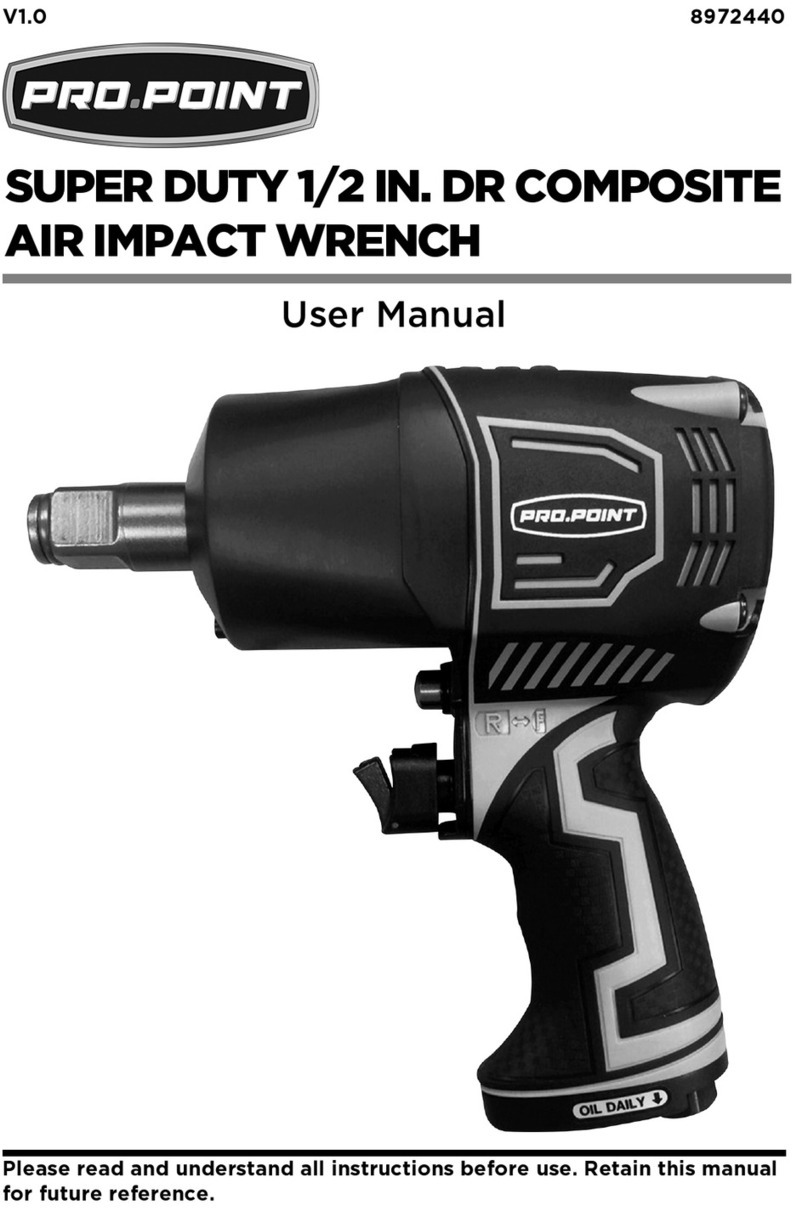
PROPOINT
PROPOINT 8972440 user manual

Central Pneumatic
Central Pneumatic 69576 Owner's manual & safety instructions

Aircat
Aircat 1320 Operating instruction
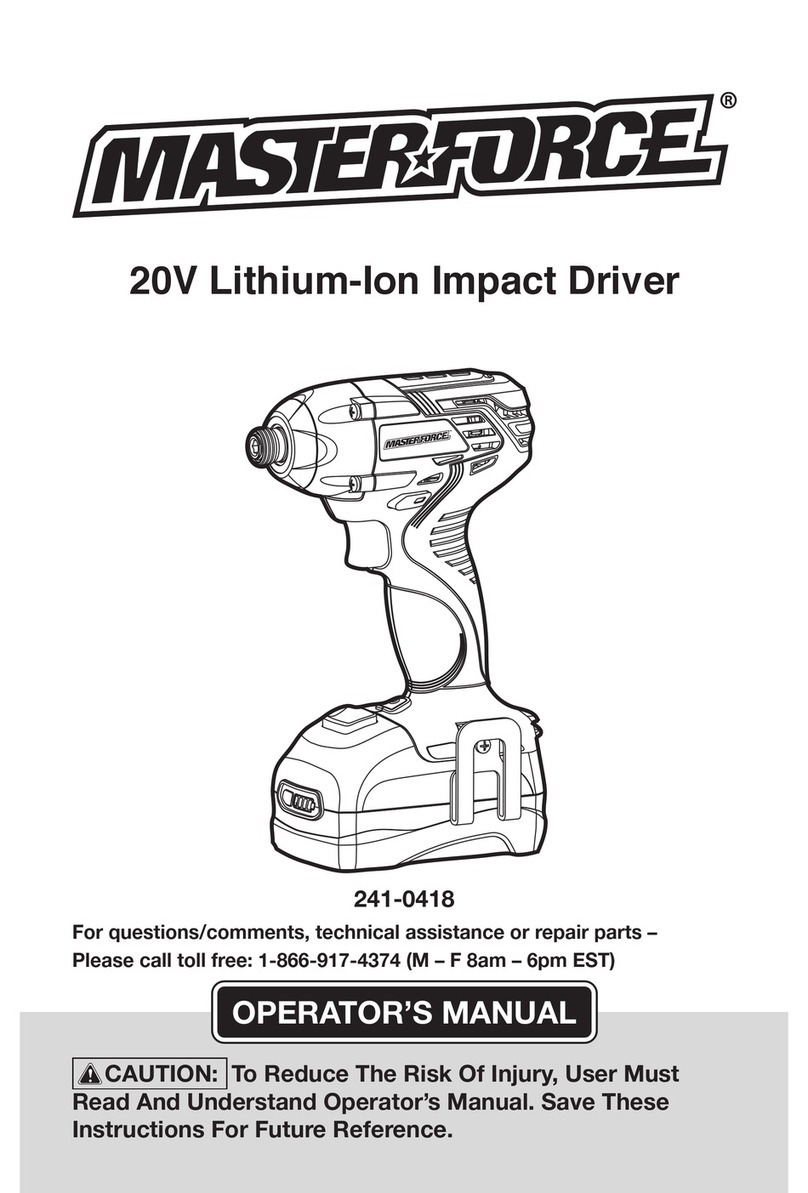
MasterForce
MasterForce 241-0418 Operator's manual

Deltafox
Deltafox DP-EIW 4533 Translation of the original instructions for use
